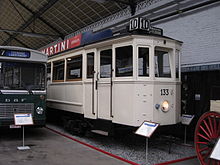Tramways Unifiés de Liége & Extensions
The Tramways Unifiés de Liége & Extensions (TULE) was a Belgian transport company based in Liège . It was created on March 5, 1927 through the merger of Tramways Communaux ( TC ), Tramways Liégois ( TL ) and Tramways Est-Ouest ( EO ). The lines 1 to 16 of the tram Liege were served by TULE.
history
tram
The TULE opened three new tram lines with the numbers 17 to 19. In order to avoid investments in new rolling stock, the company later switched a number of tram lines to trolleybus operation. On August 31, 1964, the last trams ran on lines 1 and 4.
trolleybus
The first thing that was changed in 1930 was tram line 20. The manufacturer of the first trolleybuses was Ransome from England. Good experiences led from 1930 to 1939 to the construction of further trolleybus routes (21 to 26 and 36). Between 1954 and 1956, tram lines 10, 11 and 12 were replaced by trolleybuses. The conversion of lines 5, 13, 17 and 18 was planned. But a strong bus lobby achieved the direct replacement of the tram by buses from 1956. From 1956 the decline of the Liège trolleybus began. The last line was discontinued on November 9, 1971.
vehicles
The TULE procured 25 new railcars and modernized 35 older ones from the years 1899 to 1904. These remained equipped with the Pieper oil brake. The sidecars only had an auxiliary brake. Some of the vehicles that have been preserved can be seen today in the Liège Transport Museum . In addition to various tower cars, there are also many parts that are required to operate an overhead line.
fusion
In 1964, from the merger of Tramways Unifiés de Liége & Extensions (TULE) and Société Anonyme des Railways Economiques Liège-Seraing & Extensions (RELSE), the Société des Transports Intercommunaux de la Région Liégeois (STIL) was created.
Individual evidence
- ↑ M. Lambou: History of public transport from Liege

